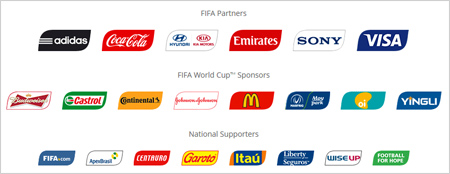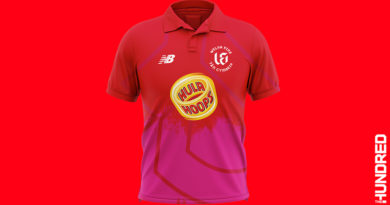The World Cup of Brands part 1: Meet the Sponsors
Posted by: Dr John Jewell
As the domestic football season draws to a close, thoughts inevitably turn to World Cup 2014. To be staged in Brazil in from 12th June to the 13th July, progress to the tournament’s start has been beset by controversies and dispute.
There is opposition to the cost of staging the competition from Brazilian citizens, with a recent poll indicating that just 48% of the population support the country’s host status, believing that the money spent on the contest be better directed to improving education, eradicating corruption and improving health care.
Added to this, latest reports suggest that structural preparations to ensure that stadia and city infrastructure are physically ready to accommodate matches are critically behind schedule. FIFA, the world governing body of football, has expressed serious concerns that at least four venues will be unready for the start of the tournament whilst The Washington Post has stated that a monorail to link Sao Paulo’s airport Congonhas will not be ready until 2015 with just eight of a planned 25 airlines operating at the terminal during the World Cup. The BBC has reported that the whole process of getting ready for the event has been chaotic and at times disastrous.
This may be all part of an unfounded pessimism that seems to be characteristic of how we approach major sporting events now: who can forget the run up to London 2012 and the hysteria generated over whether the city’s security and transport systems would cope?
I think we can be fairly certain that the World Cup will take place in Brazil and, for some at least, be a resounding success. This is because there is simply too much global investment in the bonanza for it to fail. For the multinational brands and corporations a phenomenal amount has been spent already. As Adage magazine reported when Brazil hosts the World Cup later this year, it will be like, ‘having the Super Bowl every day for an entire month. Eight marketers are paying Brazil’s dominant TV network Globo a total of $600 million for a TV presence around the soccer games and related coverage. At $75 million per sponsor, that’s the equivalent of almost 20 thirty-second Super Bowl spots each for AmBev, Coca-Cola, Banco Itau, Johnson & Johnson,Hyundai, Nestle, wireless business Oi and local retailer Magazine Luiza.’
FIFA itself has a three tier commercial hierarchy of sponsors and associates. On the top level are the six ‘official’ partners comprising: Adidas, Coca Cola, Hyundai, Emirates, Sony and Visa. According to IEG Sponsorship Consultancy these companies pay an annual fee to FIFA of between $24 and $44 million dollars for global rights to a full range of football activities in World Cup year or not. On the second level are 8 World Cup ‘sponsors’ , such as BP, Budweiser and McDonald’s who pay between $10 and $25 million annually for, ‘rights to the event on a global basis, including category exclusivity, select marketing assets and secondary media exposure.’ Lastly, FIFA has a relationship with 6 ‘national supporters’ paying between $4.5 million and $7.5 million a year for the privilege of promotion and association with the tournament.
Of course, these companies don’t pay these sorts of sums for the hell of it: events such as the Olympics or the World Cup are massive revenue generators. In June 2013, Adidas chief executive Herbert Hainer told Oregon Media that the business’ ‘soccer unit’ would earn a record 2 billion Euros in 2014. ‘Through the World Cup we will once again underline our leading position and share our passion for the game with fans around the world,’ Hainer said. Brands like Coca Cola and McDonald’s hope to benefit from the global exposure with an increase in sales in the short term (while the tournament is on) and by continuing to build upon the association that they have cultivated with sport over a sustained period of time. In 2010 Steve Easterbrook, McDonald’s chief for Northern Europe, summed up the ethos: ‘most of our staff love football and most of our customers love football, so there is a very ‘sweet spot’ for us there, it is a glue that holds us all together.’
This last point is vital. Just this week, Javier Sanchez Lamelas group marketing director in Europe for Coca-Cola told the Guardian that the ideas of ‘universality’ and ‘togetherness’ were the two values that Coke wanted to stress at World Cup 2014. He said, ‘That is the way we are building our communication around the event. I think this is the one of the few moments in history where the whole world comes together. It’s beautiful.’
So brands want to tap into goodwill and expectancy generated by the World Cup. As I’ve written before, the theory is that the sporting environment, live or otherwise, delivers the consumer to the advertiser in precisely the right state of mind to be receptive to persuasive messages and constant presence. The ultimate quest is that the affinity between an individual and an event can rub off on the sponsor. In terms of football, as Marshal Cohen, chief industry analyst of The NPD Group, Inc has stated, ‘It is the world’s most popular sport. You’re talking about marketing to fanatics (and) they’re will to spend big dollars.’
But woes betide those that aren’t part of FIFA’s elite cooperation. Only authorised event stakeholders of the FIFA World Cup are legally allowed to use images of the official emblem, the official Mascot and trophy and use phrases such as ‘Brazil 2014’, ‘Copa 2014’ etc. According to FIFA’s website, ‘specific legislation has been implemented to prevent illegal marketing categories which refer to the FIFA World Cup. This legislation specifically prohibits ambush marketing by association, giving FIFA the opportunity to take action against those who seek to take commercial advantage of the goodwill vested in our events through ambush marketing.’
Perhaps this shouldn’t be too surprising – in London 2012 the word ‘Olympics’ could not be used without authorisation and non-sponsors couldn’t use words or phrases which suggested a relationship with the events. This meant that the words, Games, Two Thousand and Twelve, 2012, Twenty-Twelve, used in conjunction with the words London, medals, sponsors, summer, gold, silver or bronze was illegal.
The amount of money spent on sports marketing and broadcasting is phenomenal and it’s apposite that this article ends with reference to the Olympics. On Wednesday, the International Olympic Committee announced that NBC network in the US will pay $7.5bn for exclusive rights to broadcast the (Summer and Winter) Olympics from 2021 through to 2032. Yes, 7.5 billion. And if you consider that NBC sold about $1.2 billion in ads for the 2012 Summer Olympics alone – it’s not even a risk.


